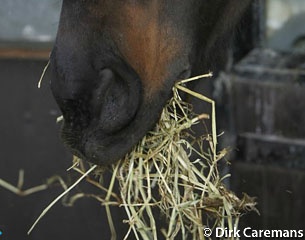
The importance and benefits of a high quality forage diet for young horses as well as sport horses in training continue to be proven by scientific research. Researchers at the Department of Animal Nutrition and Management of Swedish University of Agricultural Sciences in Uppsala carried out two interesting studies on forage-only diets.
A forage-only diet alters the metabolic response of horses in training
Researchers A. Jansson and E. Lindberg of the Department of Animal Nutrition and Management at Swedish University of Agricultural Sciences in Uppsala have researched the benefits of a forage-only diet for horses in training.
Most athletic horses are fed a high-starch diet despite the risk of health problems. Replacing starch concentrate with high-energy forage would alleviate these health problems, but could result in a shift in major substrates for muscle energy supply from glucose to short-chain fatty acids (SCFA) due to more hindgut fermentation of fibre. Dietary fat inclusion has previously been shown to promote aerobic energy supply during exercise, but the contribution of SCFA to exercise metabolism has received little attention.
Research: This study compared metabolic response with exercise and lactate threshold (VLa4) in horses fed a forage-only diet (F) and a more traditional high-starch, low-energy forage diet (forage-concentrate diet - FC).
The hypothesis was that diet F would increase plasma acetate concentration and increase VLa4 compared with diet FC. Six Standardbred geldings in race training were used in a 29-day change-over experiment. Plasma acetate, non-esterified fatty acids (NEFA), lactate, glucose and insulin concentrations and venous pH were measured in samples collected before, during and after a treadmill exercise test (ET, day 25) and muscle glycogen concentrations before and after ET. Plasma acetate concentration was higher before and after exercise in horses on diet F compared with diet FC, and there was a tendency (P = 0.09) for increased VLa4 on diet F. Venous pH and plasma glucose concentrations during exercise were higher in horses on diet F than diet FC, as was plasma NEFA on the day after ET. Plasma insulin and muscle glycogen concentrations were lower for diet F, but glycogen utilisation was similar for the two diets.
Results: The results show that a high-energy, forage-only diet alters the metabolic response to exercise and, with the exception of lowered glycogen stores, appears to have positive rather than negative effects on performance traits. (Source)
Growth, training response and health in Standardbred yearlings fed a forage-only diet.
The aim of this study was to, from a holistic perspective, describe the effects of a forage-only feeding system and a conventional training program on young Standardbred horses and compare data with similar observations from the literature.
Research: Sixteen Standardbred colts fed a forage-only diet for 4 months from breaking (August to December) and with the goal to vigorously trot 5 to 7 km at a speed of 5.6 m/s (3 min/km) were studied. The horses were fed grass haylage (56 to 61% dry matter (DM), 2.80 to 3.02 Mcal DE/kg DM and 130 to 152 g CP/kg DM) ad libitum, 1 kg of a lucerne product and minerals. The amount of training and number of training sessions were documented daily, and feed intake and body development were measured once every month. Heart rate (HR) was measured during and after a standardized exercise test in October and December. In December, a postexercise venous blood sample was collected and analyzed for plasma lactate concentration. Muscle biopsies (m. gluteus medius) were taken and analyzed for glycogen and fiber composition. Health was assessed in October and November by an independent veterinarian using a standardized health scoring protocol. BW and height at withers increased from 402 to 453 kg (root mean square error (RMSE) 6) and from 148.7 to 154.1 cm (RMSE 0.7), respectively, and the body condition score was 4.9 (RMSE 0.2) at the end of the study. Muscle glycogen content was 532 mmol/kg dry weight (s.d. 56). There was a significant decrease in postexercise HR (81 v. 73 bpm, RMSE 8), and the individual amount of training was negatively correlated with HR during and after exercise. Health scores were high and similar at both assessments (8.4 and 8.4 (RMSE 1.0) out of 10; P > 0.05), and the number of lost training days per month due to health problems was <0.9, with the exception of November (5.3 days).
Result: It is concluded that yearlings in training fed high-energy forage ad libitum can reach a conventional training goal and grow at least as well as earlier observations on yearlings of other light breeds. (Source)
Related Links
Nocturnal Sleeping and Eating Patterns of Horses on Straw and Shavings
Horses and Abnormal Behaviour Investigated in Three Counties in Sweden
Thelwell was Right: Chubby Ponies Misbehave More